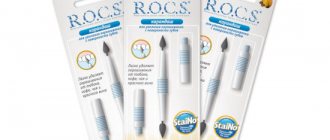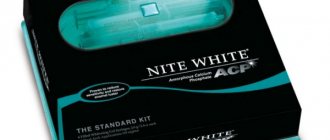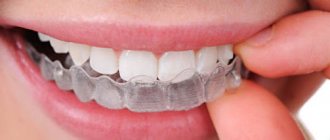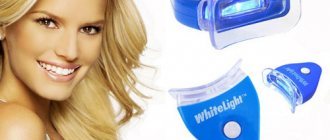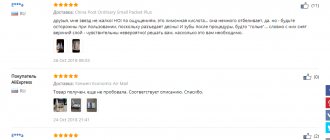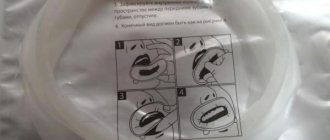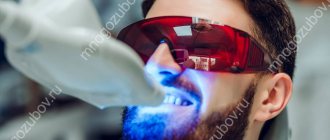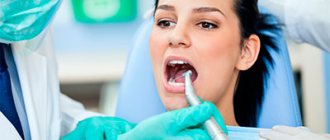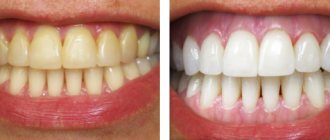Modern professional products now allow whitening by 1-2 shades, and sometimes by more than 10 shades. Teeth whitening White Perfect is one of the TOP systems.
It is recommended to whiten teeth before prosthetics or installation or replacement of fillings. Before whitening, it is required that the mouth be sanitized, dental deposits in the form of plaque and tartar removed, and inflammation of the gums relieved.
Contraindications to bleaching:
- periodontal inflammation;
- childhood;
- allergy.
Smoking is considered a relative contraindication. Restrictions on use: unsatisfactory hygienic condition of the oral cavity, pregnancy, individual intolerance.
Indications and contraindications for teeth whitening
Professional teeth whitening is the lightening of tooth enamel by one or two or more shades. It can be carried out either in a specialized dental clinic or at home.
Indications for lightening are as follows:
- stable dark color of the tooth surface;
- formation of colored stains from coffee, wine, tea and other food products that are not removed during the cleaning process.
Main contraindications:
- pregnancy and breastfeeding;
- increased sensitivity to thermal, chemical, mechanical irritants;
- severe abrasion due to various reasons;
- presence of wedge-shaped defects;
- the appearance of numerous enamel cracks;
- diagnosis of caries with unfilled carious cavities;
- a large number of fillings that are not affected by whitening agents.
If there are single fillings after completion of whitening, they must be replaced by selecting the appropriate shade.
Another question that patients ask is whether professional teeth whitening is harmful. If it is carried out by an experienced specialist, strictly adhering to all prescribed recommendations, then the procedure will not cause any visible harm to health. You should not overuse lightening, repeat it too often, using aggressive pastes in between, otherwise there is a danger of thinning the enamel. And this, in turn, leads to the destruction of dental crowns. Read more about the dangers of whitening for tooth enamel »
Teeth whitening: a brief educational program
Teeth whitening methods
Whitening methods can be divided into two types:
- Professional whitening - you need to go to the dental clinic for it. This includes photo bleaching, chemical bleaching, ultrasound, and laser. These methods require medical knowledge, skills and special equipment. These are usually quite expensive procedures, but at the same time the safest and most effective. We would recommend them.
- Home whitening. This includes both traditional methods and special modern means. We won’t talk about grandma’s methods like lemon peels and activated carbon, but we will dwell on various types of special equipment in more detail. These include:
- whitening toothpastes and powders . The very first and most common, but not the most effective option. Typically, these toothpastes and tooth powders act as abrasives, removing a thin layer of enamel along with plaque. In addition, there are very effective enzymatic and chemical whitening toothpastes. This method really helps to lighten your teeth, but it can seriously harm your health, so buy only good toothpastes and use them for no longer than a month;
- Mouth rinses are a good addition to toothpaste and generally a good thing for oral hygiene. The effectiveness of whitening, of course, is unlikely to amaze you, but mouth rinses act gently, fight germs, freshen breath, and maintain normal acid-base balance and humidity in the mouth;
- erasers for teeth are ordinary polyester erasers, only they need to be used to erase not pencil marks from paper, but stains from teeth. Quite a strange invention of a Chinese genius. Of course, an eraser will not help whiten your teeth for a long time, but it will remove the effects of drinking coffee or red wine;
- whitening varnishes - they do not so much change the tone of tooth enamel as simply paint over it. This is a quick, short-term method used when there is no time for thorough whitening. The varnish is erased, for example, by food, but it will still last one evening, so it can be used before an interview, a reunion or other important event;
- gels are not as effective as chemical whitening in the dentist’s office due to the lower concentration of the active substance, but they are cheaper, are not as dangerous if used incorrectly, and can be used at home. The gel is applied to the teeth using a brush: this must be done carefully, because if it gets on the mucous membrane it can cause serious irritation. Typically the course takes about two weeks. The most convenient format for producing gels is pencils. They are small, convenient, you can take them with you on a trip and use them on the road;
- Mouth guards are not so much an independent product as a way to enhance the effectiveness of the whitening gel. The trays are placed on the teeth before bed for an hour or two or even throughout the night. They can be either standard sizes - the main thing here is not to miss - or thermoplastic, that is, capable of taking the shape of your teeth after heating;
- strips - they are glued to the teeth using fixing compounds, and the agent with which the strips are impregnated is responsible for whitening. Just like mouth guards, the strips are usually applied before bedtime. Their advantage is that you can do household chores and not be distracted by the whitening procedure, which happens as if by itself. Quite effective, safe and inexpensive method.
Contraindications to teeth whitening
Since bleaching somehow affects the enamel, before using any product, pay attention to contraindications. General contraindications to teeth whitening include:
- children's age (up to 16 years);
- pregnancy, breastfeeding;
- any diseases of teeth and gums;
- increased sensitivity of teeth;
- enamel damage: chips, cracks, caries;
- allergy to the active substances of whitening products: hydrogen peroxide and carbamide peroxide;
- anomalies in the eruption of wisdom teeth;
- taking antibiotics and other medications that can affect the color of tooth enamel;
- oncological diseases.
In any case, before using bleaching products, read the instructions, and if you have any doubts, consult a specialist for advice.
How to maintain the result after teeth whitening with drugs from the pharmacy
Home whitening cannot provide as long-lasting results as professional procedures. Therefore, in order to keep your teeth white for as long as possible, after and during whitening, follow three simple rules:
- exclude coloring foods and drinks from your diet: coffee and tea, red wine, soy sauce, beets, carrots, berries;
- pay due attention to oral hygiene: brush your teeth thoroughly twice a day, use dental floss and mouthwash;
- stop smoking or at least reduce the number of cigarettes you smoke.
Kinds
There are clinical (office, office) and home whitening. The first is carried out in a dental clinic by a dentist, takes about two hours, after which the teeth become snow-white. The second is done at home by the patient himself, but as prescribed by a doctor. Whitening at home takes a little longer - from 3 to 14 days. The achieved effect in both cases is not much different.
Depending on the condition of the teeth, it is possible to lighten the enamel by 10-12 shades.
Method of in-office whitening
If during the examination a carious lesion or the presence of root tartar is detected, the doctor carries out sanitation of the oral cavity (this may require more than one visit to the clinic). Immediately before whitening, the dentist will determine the required concentration of the active substance (hydrogen peroxide). If the enamel is in good condition, it can reach 40%; if the enamel is thin and has microcracks, it can reach no more than 20% (naturally, in this case the effectiveness of the procedure is somewhat reduced). The mucous membrane of the oral cavity is covered with a special gel, the skin of the lips and cheeks is covered with protective aprons. The whitening effect is noticeable immediately. A slight increase in sensitivity disappears after 2-3 days.
The White Perfect office whitening system is the latest development of the German company WILLMANN&PEIN, which combines all the advantages of previous whitening systems. It is used for both superficial and intracanal bleaching. In one visit, it is possible to lighten the enamel of the entire dentition. During the procedure, the patient does not experience any discomfort.
As a rule, in one session the enamel is whitened by 4-8 shades, which is incomparable with gels and pastes for home use.
The components of the drug do not have an aggressive effect. The standard duration of the procedure is 30 minutes. According to the results of numerous clinical studies, White Perfect whitening is the safest among similar systems. The list of contraindications is very small: pregnancy, lactation, age under 18 years and individual intolerance to the drug.
Methods
As the name suggests, professional whitening is carried out in a clinic, under the constant supervision of a dentist or hygienist. There are several methods, which we will discuss in more detail.
Laser whitening
A fast, effective, safe and painless way to whiten enamel. Removes color stains from the surface, brightens the color by 5-7 tones. The patient's teeth are coated with a gel containing molecular oxygen and illuminated with a special diode laser. Under its influence, pigments are removed from the enamel.
Advantages of laser whitening:
- teeth remain white for a long time, up to several years;
- one procedure is enough to achieve a positive effect;
- Laser treatment strengthens tooth enamel; it becomes not only lighter, but also less sensitive to various irritants.
Gel whitening
Allows you to lighten the surface by 4-12 tones within one hour. An active gel-like substance is applied to the tooth enamel, which acts both independently and under the influence of light irradiation. The procedure usually lasts from 30 minutes to an hour. Read more about gel whitening »
Whitening with Zoom 3 lamp
A modern whitening method for business people with a constant lack of free time, lasts approximately one hour, allows you to whiten your teeth by 7-8 shades. Light-activated hydrogen peroxide gel is applied to the surface, after which they are treated with a special Zoom lamp! The procedure is completed with fluoride treatment to consolidate the result. Read more about whitening using Zoom 3 technology »
Before starting whitening, it is very important to isolate the patient’s lips and gums from exposure to aggressive drugs.
Airflow
Popular professional cleaning procedure Air Flow. It does not whiten teeth, but simply returns them to their original natural color, eliminating darkening of the enamel and food stains. Under high pressure, the enamel surface is treated with a mixture of water and abrasive powder. In this way, any dental deposits are removed; they are literally erased from the surface of the enamel, falling into the dental vacuum cleaner. The process is completely painless, is carried out without anesthesia, and lasts about 30-40 minutes.
Advantages of the Air Flow system:
- removes plaque even in the most difficult to reach places;
- brightens enamel by 3-4 tones in one session;
- prevents the occurrence of gum diseases;
- used for cleaning braces and implants.
Contraindications:
- inflammatory periodontal diseases;
- chronic bronchitis or asthma;
- allergic reaction to citrus fruits (the powder has the smell and taste of lemon).
To avoid staining of teeth, it is necessary to refrain from drinking coffee, cocoa, tea, red wine and other dyes in the first hours after the procedure.
Beyond Polus (USA)
Multifunctional system for comfortable, safe, convenient, effective whitening. Consists of a halogen whitening accelerator, built-in LEDs, low-level laser therapy. Allows you to whiten each tooth individually, or both jaws at the same time. Does not allow temperature increases and ultraviolet radiation. The duration of the procedure is about 30 minutes, the sustainability of the achieved result depends on the patient’s lifestyle, his eating habits, and the presence or absence of bad habits.
Opalescence Xtra Boost
An innovative whitening method that does not use light lamps. The method is based on a 38% solution of hydrogen peroxide in the form of a gel, which is applied to the vestibular surface of the teeth about 1 millimeter thick. The gel is removed using a dental vacuum cleaner after 15 minutes, after which it is washed with a stream of water using a vacuum suction.
It is important to protect the soft gum tissue with the OpalDam barrier.
If necessary, the procedure can be repeated, but only if there is no increased sensitivity of the teeth to external irritants. Read more about the Opalescence whitening system »
White & Perfect (Germany)
The White & Perfect system is not aggressive, does not damage tooth enamel, and does not cause side effects. A thin layer of special gel applied to the surface, under the influence of ultraviolet radiation, brightens it by several tones.
«
Benefits of White Perfect
The advantages of the system include:
- Excellent results and effectiveness of the drugs;
- High-quality, safe composition;
- Fast whitening process – 30 minutes;
- The ability to carry out the procedure 3 days in a row to achieve the desired result;
- Safety for teeth and body;
- Ease of manipulation;
- Affordable price;
- There is no need to use special expensive equipment;
- Absolutely painless procedure;
- The entire process is controlled by a dentist;
- The condition of the oral cavity organs improves;
- The result lasts for a long period of time.
Read more about the procedure in the source: https://putstom.ru/otdeleniya/otbelivanie/ofisnoe-otbelivanie-white-perfect.
Professional teeth whitening at home
With the help of your dentist, you must first select the most suitable system for self-whitening; fortunately, the market allows you to do this quite easily.
Whitening gels contain, in addition to flavoring additives, types and glycerin, 10 percent carbamide peroxide. The latter is considered the most effective and safe.
Repeated courses should be carried out as necessary.
In the presence of chronic diseases, allergic reactions, hypersensitivity, during pregnancy and breastfeeding, home whitening is strictly prohibited!
During teeth whitening, you must strictly adhere to your doctor's recommendations.
Home whitening is contraindicated in the following cases:
- tooth mobility;
- inflammatory gum diseases;
- exposure of roots;
- allergy to carbamide peroxide;
If you follow the instructions, teeth whitening at home is not harmful to the patient. Excessive use of whitening gels can lead to complete thinning of tooth enamel.
Luma White Plus (Opalescence)
A unique professional teeth whitening system at home. Consists of a special gel, a dental tray, and a light source. The gel is applied to the inner surface of the mouth guard, which is placed on the teeth and fits tightly to them. The lamp is aimed directly at the mouth guard and should shine for about 10 minutes. The maximum wearing time is 30 minutes per day. Longer or more frequent use causes damage to the enamel.
To achieve optimal results, the procedure must be repeated daily for 5-7 days.
How does whitening happen?
The manipulation is carried out in a dental clinic or office. First, the dentist examines the oral organs, assesses their condition, and determines the patient’s wishes. Dental preparation is carried out: professional hygiene, treatment of caries, gingivitis and other oral diseases.
The lightening procedure consists of the following stages:
- Elimination of dental plaque;
- Isolation of soft tissues, gums;
- Drying teeth;
- Applying a thin layer of whitening gel;
- Activation of the gel with a photopolymer lamp and catalyst;
- Removing drug residues;
- Evaluation of the result;
- Repeat the procedure if necessary;
- Recommendations for the patient.

